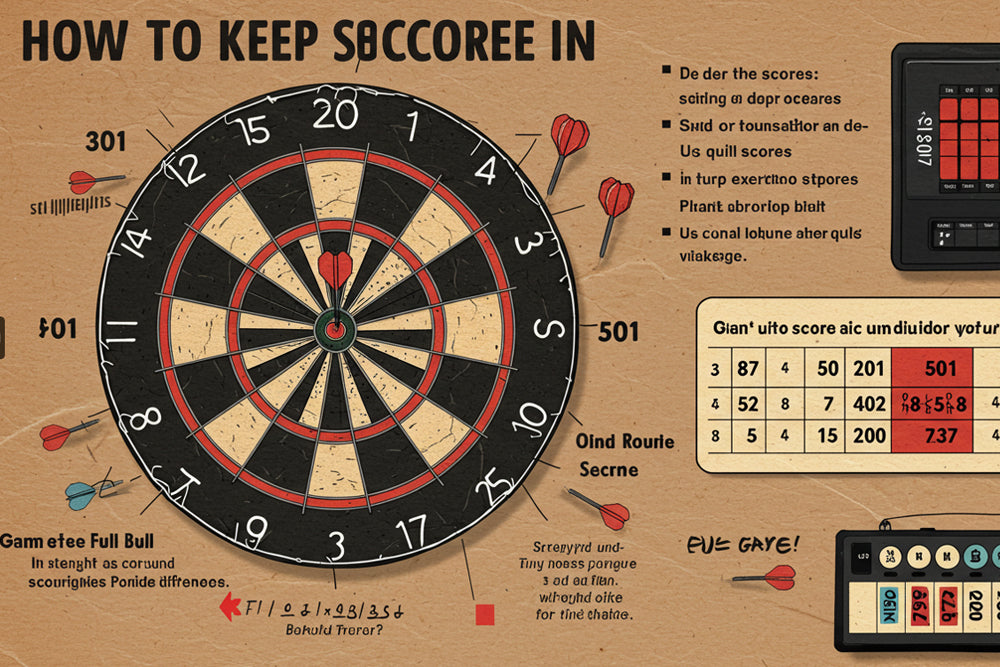Darts is a game of skill, precision, and strategy, enjoyed by millions around the world. Whether you’re playing casually with friends or competing in a league, understanding how to keep score is essential. This guide will walk you through the various scoring methods used in darts, tips for improving your game, and the importance of scorekeeping in enhancing your overall experience.
Understanding the Basics of Darts Scoring
Before diving into the specifics, it’s crucial to understand the basic components of a dartboard. A standard dartboard is divided into 20 numbered sections, a bullseye, and an outer bull. Each section has a different point value, ranging from 1 to 20. The outer bull is worth 25 points, while the inner bull (the center of the bullseye) is worth 50 points.
The Main Game Formats
There are several popular game formats in darts, each with its own scoring rules:
-
501: The most common format played in tournaments. Each player starts with 501 points and aims to reduce their score to exactly zero by hitting specific areas of the board. The game requires a double to finish.
-
301: Similar to 501, but each player starts with 301 points. This format is often used for shorter games.
-
Cricket: A strategic game where players aim to hit numbers 15 through 20 and the bullseye. To win, a player must "close" all numbers while having a higher or equal score than their opponent.
-
Around the World: Players must hit each number on the board in order, from 1 to 20, and then finish with the bullseye.
Keeping Score in 501 and 301
Step-by-Step Scoring Guide
- Starting Points: Begin with the total score (501 or 301).
- Throwing Darts: Each player throws three darts per turn.
- Calculating Points: After each turn, add the points scored from the darts to the player’s current score.
- Subtracting Scores: Subtract the points scored from the starting total.
- Winning the Game: To win, a player must reach exactly zero, landing on a double. If a player goes below zero, their score resets to what it was at the start of that turn.
Example
- Player A starts with 501 points.
- In their first turn, they score 60 points (20 + 20 + 20).
- Their new score is 441 (501 - 60).
- If they score 40 on their next turn, their score becomes 401 (441 - 40).
- If they then score 50, their total is now 351 (401 - 50).
Important Rule: Doubling Out
To finish the game in 501 and 301, a player must hit a double. For example, if a player has 40 points left, they must hit the double 20 to win. This rule adds a layer of strategy, as players must plan their throws carefully.
Keeping Score in Cricket
Step-by-Step Scoring Guide
- Target Numbers: Players aim for numbers 15 through 20 and the bullseye.
- Closing Numbers: A player closes a number by hitting it three times.
- Scoring: Once a player closes a number, they can score points by hitting that number before their opponent closes it.
- Winning the Game: A player wins if they close all numbers and have a higher score than their opponent.
Example
- Player A hits the 15 three times to close it.
- They then hit the 15 again, scoring 15 points against Player B.
- Player B must hit 15 three times to close it and prevent further scoring.
Tips for Effective Scorekeeping
- Use a Score Sheet: Keeping a physical score sheet helps track points clearly.
- Designate a Scorekeeper: If playing with multiple players, appoint one person to keep score.
- Stay Organized: Write scores neatly and keep track of each player's turn to avoid confusion.
- Practice Regularly: Familiarize yourself with scoring rules through practice games.
The Importance of Scorekeeping in Darts
Keeping score accurately is crucial for several reasons:
- Fair Play: Accurate scoring ensures that all players are aware of their progress and avoids disputes.
- Strategic Planning: Knowing the score allows players to plan their throws and make strategic decisions.
- Enhancing the Experience: A well-kept score can make the game more enjoyable and engaging for everyone involved.
Conclusion
Understanding how to keep score in darts is essential for enjoying the game and improving your skills. Whether playing 501, 301, or Cricket, accurate scorekeeping enhances the competitive spirit and fosters camaraderie among players.
